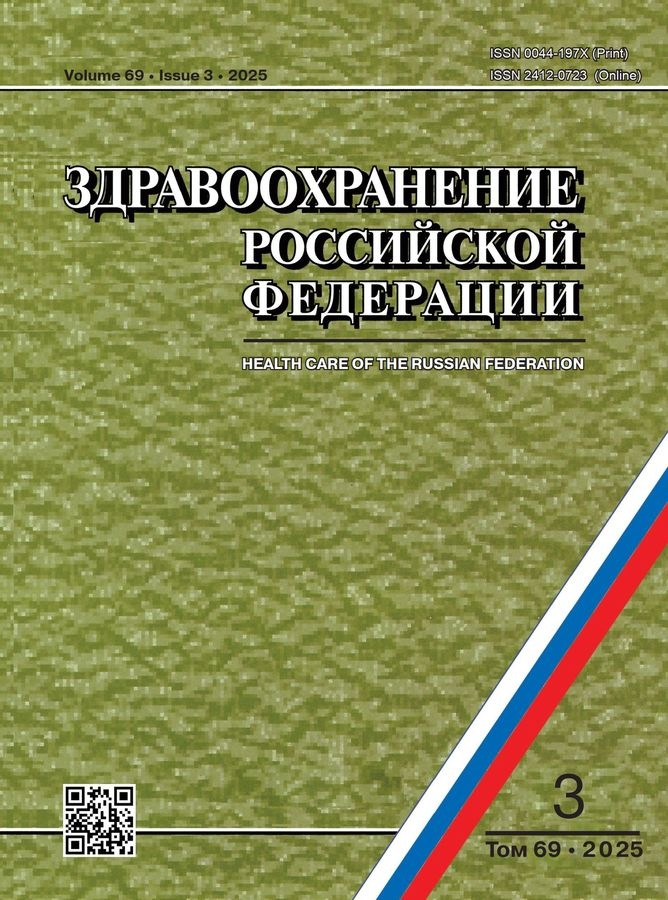Trend and elimination reserves of life expectancy in the population in the Krasnoyarsk Territory
- 作者: Baran O.I.1, Kutumova O.Y.1, Babenko A.I.1
-
隶属关系:
- Research Institute for Complex Problems of Hygiene and Occupational Diseases
- 期: 卷 69, 编号 3 (2025)
- 页面: 232-239
- 栏目: HEALTH CARE ORGANIZATION
- ##submission.dateSubmitted##: 24.09.2025
- URL: https://bulletin.ssaa.ru/0044-197X/article/view/691308
- DOI: https://doi.org/10.47470/0044-197X-2025-69-3-232-239
- EDN: https://elibrary.ru/nsjyst
- ID: 691308
如何引用文章
详细
Introduction. In modern conditions, the main factor in preserving the people in Russia is a decline in mortality and gain in life expectancy, which is especially important for the territories of Siberia and requires detailed study.The purpose: to study the trend in life expectancy in the population of the Krasnoyarsk Territory, the impact on it changes in mortality at certain ages and from leading causes, and elimination reserves.Materials and methods. Age-specific mortality rates from the Russian Fertility and Mortality Database were used. Methods: indirect (demographic) method of constructing mortality tables to calculate life expectancy; E.M. Andreev method to calculate the components of differences and elimination reserves of life expectancy corresponding to individual ages and causes of death.Results. Life expectancy in men in the Krasnoyarsk Territory for 1990–2021.on average was by 2.0 years lower in women than in the Russian Federation. Until 2019, the gain (declinee) of the indicator was largely due to changes in mortality in working age (especially among men), from diseases of the circulatory system and external causes. More than 80% reduction in the indicator for 2019–2021 was associated with mortality from COVID-19. The life expectancy reserve in 2021 was 13.49 years for men and 9.42 for women. The most significant reserves are associated with the elimination in mortality from COVID-19, diseases of the circulatory system, external causes, and neoplasms.Research limitations. Territorial and temporal: the study was conducted for the population of the Krasnoyarsk Territory, 1990–2021. The estimated life expectancy reserve is higher than the real one.Conclusion. When planning the activities of the healthcare system, developing social and demographic programs, in which special attention must be paid to the territories in the east of the country, including the Krasnoyarsk Territory, it is important to know what impact changes in mortality (at what ages and from what causes) have on the trend in life expectancy life, what reserves exist to increase it.Compliance with ethical standards. The study does not require submission of the opinion of the Biomedical Ethics Committee or other documents.Contribution of the authors: Baran O.I. — concept and design of the study, collection and statistical processing of material, compilation of a list of references, writing the text; Kutumova O.Yu. — research concept and design, editing; Babenko A.I. — research concept and design, editing. All authors — are responsible for the integrity of all parts of the manuscript and approval of the manuscript final version.Funding. The study had no sponsorship.Conflict of interest. The authors declare no conflict of interest.Received: May 14, 2024 / Accepted: October 3, 2024 / Published: June 30, 2025
作者简介
Olga Baran
Research Institute for Complex Problems of Hygiene and Occupational Diseases
Email: baranolg@gmail.com
Olga Kutumova
Research Institute for Complex Problems of Hygiene and Occupational Diseases
Email: kutumova2023@mail.ru
Anatoly Babenko
Research Institute for Complex Problems of Hygiene and Occupational Diseases
Email: noemail@neicon.ru
参考
- Андреев Е.М., Кваша Е.А., Харькова Т.Л., Рамонов А.В., Юмагузин В.В. Смертность и продолжительность жизни в России в международном контексте: критический анализ тенденций. В кн.: Захаров С.В., ред. Население России – 2018: двадцать шестой ежегодный демографический доклад. М.; 2020: 193–262. https://doi.org/10.17323/978-5-7598-2326-1
- Нарбут В.В. Смертность населения России в трудоспособном возрасте: гендерные и территориальные различия. Высшее образование сегодня. 2016; (2): 48–51. https://elibrary.ru/vwvllx
- Аганбегян А.Г. Как восстановить сохранность народа России. Народонаселение. 2021; 24(2): 4–18. https://doi.org/10.19181/population.2021.24.2.1 https://elibrary.ru/asfwic
- Аганбегян А.Г. Демографическая драма на пути развития России. Народонаселение. 2017; 20(3): 4–23. https://doi.org/10.26653/1561-7785-2017-3-1 https://elibrary.ru/zwtfhv
- Лещенко Я.А., Лисовцов А.А. Тенденции в динамике продолжительности жизни населения в федеральных округах Российской Федерации. Социальные аспекты здоровья населения. 2020; 66(6): 9. https://doi.org/10.21045/2071-5021-2020-66-6-9 https://elibrary.ru/yrpfyu
- Лещенко Я.А., Лисовцов А.А. Ожидаемая продолжительность жизни в Сибирском федеральном округе и Иркутской области в 1990–2018 годах: тенденции и особенности. Экология человека. 2021; 28(6): 28–35. https://doi.org/10.33396/1728-0869-2021-6-28-35 https://elibrary.ru/vthwxn
- Григорьев Ю.А., Баран О.И. Тенденции продолжительности жизни населения Сибирского федерального округа (2005–2016 гг.). Гигиена и санитария. 2018; 97(7): 591–6. https://doi.org/10.18821/0016-9900-2018-97-7-591-596 https://elibrary.ru/xwpbtn
- Соболева С.В., Смирнова Н.Е., Чудаева О.В. Демографические проблемы Сибири в контексте пространственного развития. ЭКО. 2020; 50(8): 48–65. https://doi.org/10.30680/ECO0131-7652-2020-8-48-65 https://elibrary.ru/uoveuv
- Филимонов С.Н., Баран О.И., Рябов В.А. Естественное воспроизводство населения Сибирского федерального округа в начале второй волны депопуляции (особенности и прогноз). Здравоохранение Российской Федерации. 2019; 63(3): 116–21. https://doi.org/10.18821/0044-197X-2019-63-3-116-121 https://elibrary.ru/vlniqv
- Соболева С.В. Демографическая ситуация в Сибири на фоне общероссийских тенденций. Регион: Экономика и Социология. 2014; (2): 97–115. https://elibrary.ru/smgpbh
- Баран О.И., Жилина Н.М., Рябов В.А. Динамика смертности и продолжительности жизни населения трудоспособного возраста Кузбасса (2011–2018 гг.). Здравоохранение Российской Федерации. 2021; 65(3): 198–207. https://doi.org/10.47470/0044-197X-2021-65-3-198-207 https://elibrary.ru/liouft
- Андреев Е.М., Кваша Е.А., Харькова Т.Л., Пьянкова А.И., Рамонов А.В., Юмагузин В.В. и др. Тенденции смертности и продолжительности жизни в России в 1990–2020 гг. В кн.: Захаров С.В., ред. Население России – 2019: двадцать седьмой ежегодный демографический доклад. М.; 2022: 191–275. https://doi.org/10.17323/978-5-7598-2554-8
- Андреев Е.М., Кваша Е.А., Харькова Т.Л., Пьянкова А.И., Рамонов А.В. Смертность и продолжительность жизни в России: исторические успехи, бремя старых и новых проблем и их анализ с учетом результатов микропереписи населения 2015 г. В кн.: Захаров С.В., ред. Население России – 2016: двадцать четвертый ежегодный демографический доклад. М.; 2018: 302–62. https://doi.org/10.17323/978-5-7598-1772-7
- Chiang C.L. The life table and its construction. In: Introduction to Stochastic Processes in Biostatistics. New York; 1968: 189–214.
- Андреев Е.М. Метод компонент в анализе продолжительности жизни. Вестник статистики. 1982; (9): 42–7.
- Иванова А.Е. Подходы к оценке резервов снижения смертности в России. Уровень жизни населения регионов России. 2022; 18(2): 177–88. https://doi.org/10.19181/lsprr.2022.18.2.3 https://elibrary.ru/ocwsge
- Немцов А.В., Шелыгин К.В. Антиалкогольные законы 2005 г. и снижение потребления алкоголя в России. Вопросы наркологии. 2015; (1): 83–93. https://elibrary.ru/tkossz
- Андреев Е.М., Школьников В.М. Связь между уровнями смертности и экономического развития в России и её регионах. Демографическое обозрение. 2018; 5(1): 6–24. https://doi.org/10.17323/demreview.v5i1.7707 https://elibrary.ru/xochqd
补充文件







